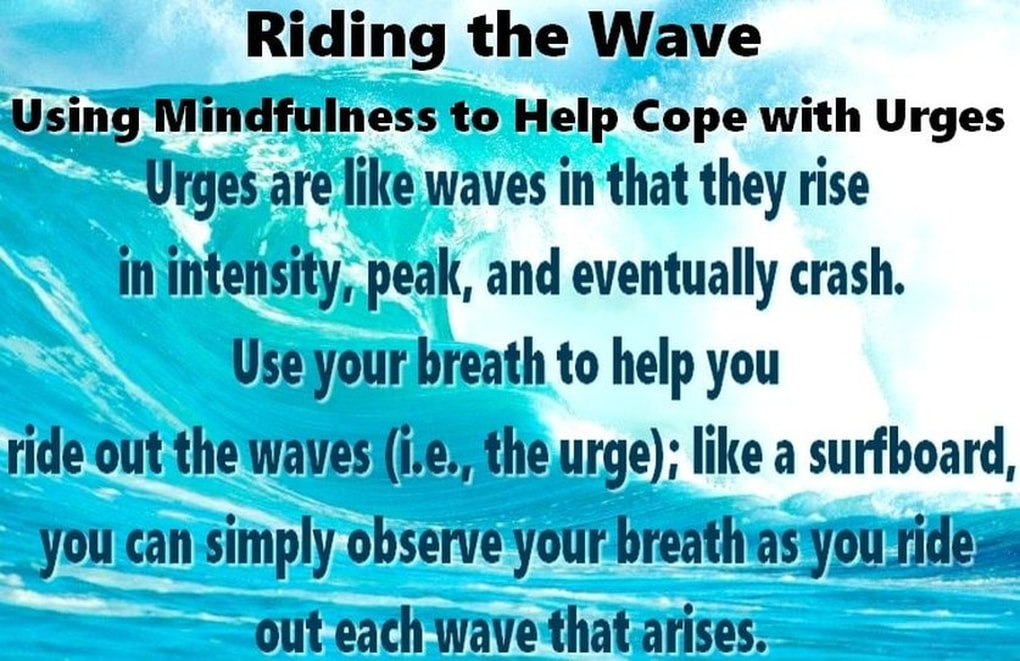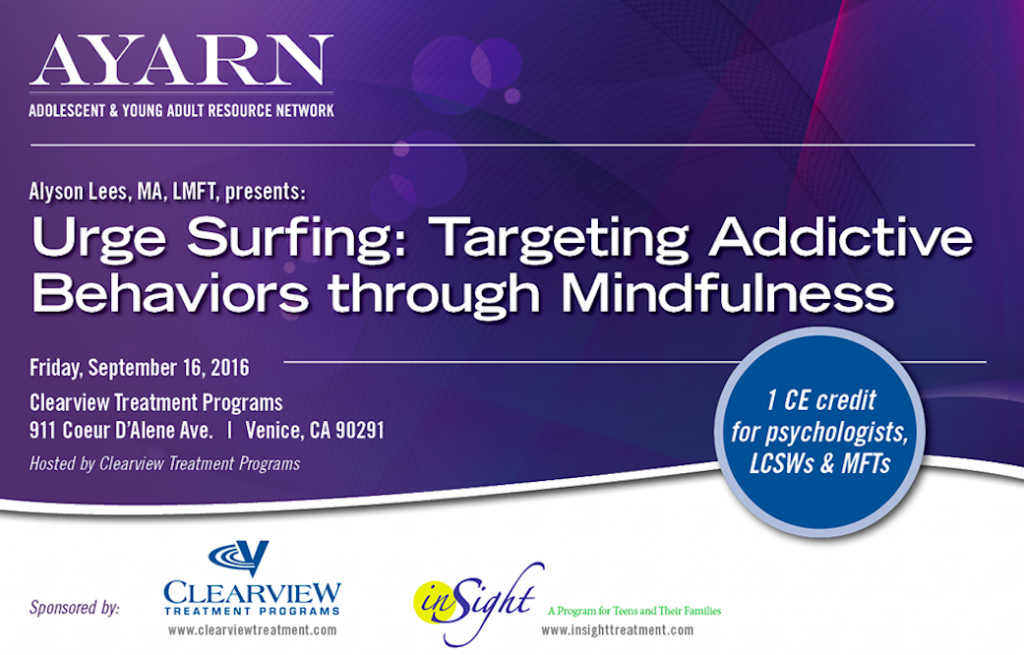Urge Surf Image2dialectical Behavioral Training
Dec 12, 2019 This term “urge surfing” was developed by G.A Marlatt, a leading psychologist who proved that there was a better way to combat substance addiction. Urge surfing is a method that can be used to help mitigate the effects of the urges we have. Urge surfing makes the claim that fighting an urge is useless. This lesson is a new acronym, that pulls the module together. This is a review, more than a full lesson. Urge Surfing (DBT-SUD) Opposite to Emotion (for changing Shame) Alternate Rebellion (DBT-SUD) Adaptive Denial (DBT-SUD) Step Eleven Sought through prayer and meditation to improve our conscious contact with God, as we understood Him, praying only for.
Resistance isn’t the only way to manage cravings and other impulses. Sometimes it’s easier to simply let go and move through what you’re experiencing without judgement—or action. In behavioral therapy, this is a distress tolerance skill known as urge surfing.
Managing Distress Tolerance
While in recovery, especially in the first few months, it sometimes feels as though every negative thought or sensation is amplified to the highest degree. You might repeatedly remember fragments of difficult conversations, misdeeds, or abuse. You could also experience tingling, nausea, pounding headaches, muscle tension, and other uncomfortable physical symptoms.
On good days, it’s easy to acknowledge the changes your mind and body are going through as progress. But when you’re overwhelmed, excessively stressed, or have a lot to reconcile from past trauma, these mental and physical challenges might feel like another brick added to a wall closing in around you. An individual’s distress tolerance level can reach its limit rather quickly, and is often a primary reason they suffer with cravings and potentially relapse.
Dialectical behavioral therapy (DBT) is one method for teaching people how to have better awareness of their internal environment. Individuals learn four methods to work through conflict, stress, and painful emotions:

- Cultivating mindfulness by being in the present moment.
- Managing distress tolerance to increase resiliency to, not avoid, trials and tribulations.
- Emotional regulation that enables an ability to manage and change difficult emotions.
- Interpersonal effectiveness boosted by assertive and respectful communication.
Urge surfing, developed by renowned clinical psychologist G. Alan Marlatt, is a successful DBT technique that incorporates these four principles.
How Urge Surfing Works

For more than 30 years, Marlatt studied addictive behavior and the patterns of old habits. He identified that many people in recovery for excessive alcohol or substance use frequently feel urges—especially the physical sensations described above—that prompt an impulse to return to old habits, or an urge to use again. Based on his work with relapse prevention and interventions, he wanted to find a way to help people in recovery acknowledge the impulse using the DBT method of mindfulness.
He developed urge surfing as a means for someone to recognize the physical and emotional sensations accompanying an urge, but not judge or act upon them. His philosophy was that urges are common, especially when someone is new to recovery or experiences a certain trigger. By staying mindful in the moment, an individual acknowledges the urge, and maybe even its origin, but that’s it—there’s no self-admonishment, shame, or guilt. By “surfing the urge” and getting to the point where it passes, it’s easier to establish that cravings are temporary. This realization puts you back in control of what you’re experiencing, and helps build stronger distress resilience. Marlatt once said, “The focus is on identifying and accepting the urge, not acting on the urge or attempting to fight it.”
Practicing the Method
Knowing how to urge surf is a terrific coping mechanism to help manage stress. Reminding yourself to stay in the present moment and ride the wave of an impulse is a powerful tool—while you might not be able to control what’s happening around you, you’re always able to control how you react to troubling circumstances and situations. Mindfulness expert Jon Kabat-Zinn refers to mindfulness as “paying attention on purpose,” and that’s exactly how you can make urge surfing work for you. Let’s walk through the process.
1. When you first start to feel uncomfortable physical or emotional sensations, acknowledge these cues.
2. Next, find a quiet place where you can sit or lie down for a few minutes.
3. Close your eyes, and direct your attention to your breath. Notice the gentle rise and fall of your chest. Count to four with every inhale, and again on each exhale. Do this for a couple of minutes.
4. Now, focus your internal gaze on the physical sensation that gave you an urge cue, such as dry mouth, shoulder tension, tingling in the fingertips or hands, or some other impression.
5. If you experienced more of an emotional reaction, such as chest tightening, racing thoughts, or an “empty” feeling, direct your attention to those sensations, just as you did with your breath.
6. Use guided imagery to help you ride the wave of cravings. Maybe your breath is a surfboard helping you glide through the water, or you notice ocean waves rise on your inhale, then land softly on the shore as you exhale. Any visual that helps you follow the ebb and flow of the urge until it subsides will help.
7. Recognize that you’re safe as you allow the urge to pass. Take a deep, cleansing breath from your stomach and let it out in a slow, long exhale to finalize this moment.
8. Now rate the urge, such as one being a mild experience and 10 being an intense craving.

Guidance Resources
Like with any new skill you learn, adapting to the urge surfing technique might take a few tries before you feel comfortable with it. If you’d like to be guided in the process, here are a few resources:
Urge Surf Image2dialectical Behavioral Training Relias
Also remember that it’s okay to examine the impulse and the circumstances that prompted it. You might understand it better by journaling or discussing it with a sponsor, therapist, or a trusted friend. Download vmware fusion 11.5 pro. This awareness provides the opportunity to understand the focus of your recovery.
The Multidimensional Approach at Twin Lakes
Talk therapy isn’t the only method people experience for addiction treatment and better health. Our board-certified medical team also uses cognitive and dialectical behavioral therapies, experiential therapy, 12-Step groups, mindfulness training, and relapse prevention programs to provide individuals with the skills that work best for them. This individualized approach to treatment establishes a greater foundation of success.

Resources:
Practice each of these techniques, so you know what they feel like. Then use them, when you feel overwhelming emotion and you feel like you need them.
T: Temperature
Similar to one of the previous techniques that we worked on, the first steps works by changing the temperature.
Dms leticiahidden hills stable. Cooler temperatures decrease your heart rate (which is usually faster when we are emotionally overwhelmed). You can either splash your face with cold water, take a cold (but not too cold) shower, or if the weather outside is chilly you can go outside for a walk. Another idea is to take an ice cube and hold it in your hand or rub your face with it.
Higher temperatures increase your heart rate (which is usually lower when you feel depressed, sad, or anxious). You can take a hot bath, nestle up in a blanket, go outside on a hot day, or drinking a warm tea.
Note, be smart about it. You don’t need to go full Wim Hof. Cold exposure can make your blood pressure drop, and heat exposure can raise your blood pressure. If you have a medical condition where this could be a problem, skip this step or consult your physician.
I Intense Exercise
When you have a built-up energy as a result of experiencing overwhelming emotions, it can be a really good idea to spend this energy by doing a cardio work-out. It doesn't have to be anything fancy - you don't need special equipment or expensive membership in a gym. Simply get on your feet and do one of the following: go for a run around the block, do jumping jacks in your room, go outside and walk fast. You can also try jumping rope, dancing or lifting weights (if you already have them). Do this for 10-15 minutes but don't overdo it. When you spend that conserved energy you will feel more tired and your overwhelming emotions will become more balanced.
P: Paced Breathing
In order to reduce the physical manifestation of the overwhelming emotions you feel (for e.g. increased heart rate, flushed face, dry mouth, sweating etc.) it helps to try to control your breathing so that its rate will eventually decrease. Try the following technique: breathe in deeply through your nose (abdominal breathing) for four seconds and then breathe out through your mouth (for six seconds). Do this for 1-2 minutes.
P Progressive Muscle Relaxation
In order to relax the tense muscles in our body while we are experiencing extreme emotions, you can try progressive muscle relaxation. You can do this from a seated position. Start with the top of your body - become aware of your muscles and the upper back and deliberately tighten them for five seconds. Then let go - you should feel the region loosening up. Keep doing this with your arms, your abdominal and back muscles, your bottom muscles, thighs and upper legs and calves. This is a great way for your body to let go of the excessive energy that has built up with the overwhelming emotions.
Example

Situation: 'Today when I woke up, I felt very empty and down. It didn't help that the weather has been dull for days now. All of this reminded me how 2 years ago, this time of the year, I was feeling very depressed and was coping with the dysfunctional relationship I have with my father. This memory made spiral down, and in no time I didn't want to go on with my day, finish the work responsibilities that I have, or do anything. As the morning went on I felt even more depressed and empty.'
T - Temperature: I chose to have a hot bath, something that will make me feel warmer, both physically and potentially emotionally as well. It felt like an act of self-kindness, and it really did help me not to fall even more into this sad memory lane.
I - Intense exercise: I put on some music since I could use having a little fun time, and I put the effort to get my muscles going and dance. I did this for 10 minutes, and I felt more energized after.
P - Paced breathing: I did two minutes of the paced breathing technique.
Urge Surf Image2dialectical Behavioral Training Reliaslearning
P - Progressive muscle relaxation: By step four, I already felt better doing the previous three. Nevertheless, I sat comfortably and did the progressive muscle relaxation instructions. I feel like the TIPP technique really helped me not to feel more empty and depressed, and I went on with my day. Alicia keys no one live.
